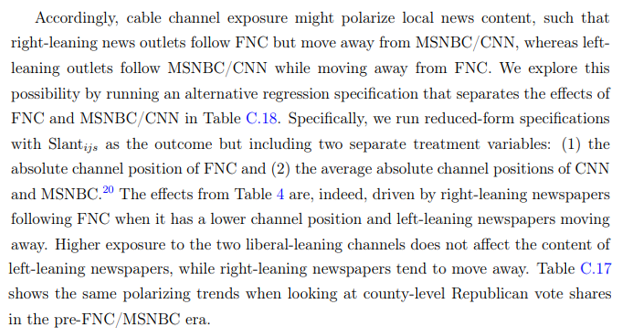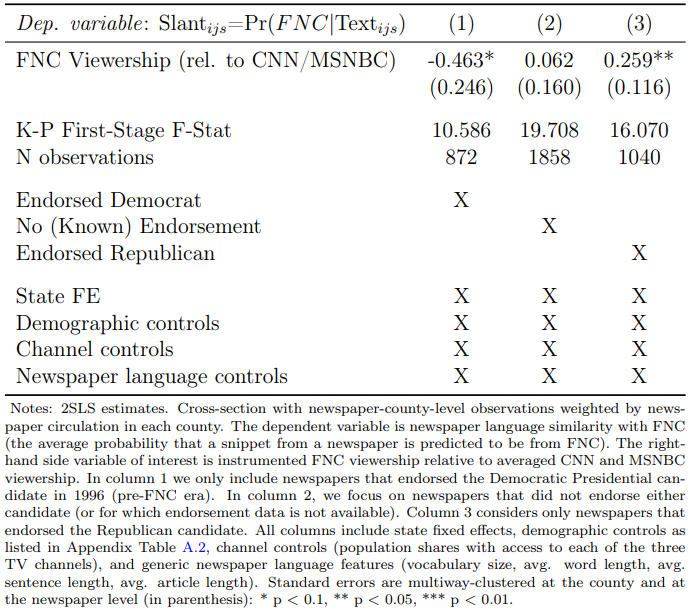and the distribution of digital products.
Cable News Media Slant Polarizes Local Newspapers
Abstract and 1 Introduction 2. Data
3. Measuring Media Slant and 3.1. Text pre-processing and featurization
3.2. Classifying transcripts by TV source
3.3. Text similarity between newspapers and TV stations and 3.4. Topic model
4. Econometric Framework
4.1. Instrumental variables specification
4.2. Instrument first stage and validity
5. Results
6. Mechanisms and Heterogeneity
6.1. Local vs. national or international news content
6.2. Cable news media slant polarizes local newspapers
\ Online Appendices
A. Data Appendix
A.2. Alternative county matching of newspapers and A.3. Filtering of the article snippets
A.4. Included prime-time TV shows and A.5. Summary statistics
B. Methods Appendix, B.1. Text pre-processing and B.2. Bigrams most predictive for FNC or CNN/MSNBC
B.3. Human validation of NLP model
B.6. Topics from the newspaper-based LDA model
C. Results Appendix
C.1. First stage results and C.2. Instrument exogeneity
C.3. Placebo: Content similarity in 1995/96
C.8. Robustness: Historical circulation weights and C.9. Robustness: Relative circulation weights
C.12. Mechanisms: Language features and topics
C.13. Mechanisms: Descriptive Evidence on Demand Side
C.14. Mechanisms: Slant contagion and polarization
6.2. Cable news media slant polarizes local newspapersFinally, we investigate effect heterogeneity regarding the prior partisan commitments of local newspapers. We distinguish three outlet groups based on 1996 U.S. presidential election endorsements: (1) those that endorsed the Republican candidate Bob Dole, (2) those that endorsed the Democrat candidate Bill Clinton, and (3) those that did not endorse either candidate. [18] Endorsements signal whether the pre-FNC/MSNBC political leaning of a newspaper was relatively conservative or liberal. The non-endorsers can be seen as politically neutral. [19]
\ Table 4 re-estimates our main specification on different newspaper subsets. Column 1 focuses on Democrat-endorsing newspapers, where we find a significantly negative coefficient, suggesting that liberal-leaning newspapers become less FNC-like in their reporting when more exposed to FNC (relative to CNN/MSNBC). Column 3 subsets on Republican-endorsing newspapers. Those behave the same as the main sample, i.e., they adopt more FNC-like content. For newspapers with no (known) endorsements (column 2), no effect emerges
\

\

\ Overall, exposure to FNC (and, to a lesser degree, CNN and MSNBC) seems to polarize local news content: Republican-leaning newspapers adopt right-wing cable news content in response to FNC viewership increases. Instead, Democrat-leaning papers become more left-wing. This dynamic is consistent with a market positioning effect (Mullainathan and Shleifer, 2005; Gentzkow et al., 2014), where the conservative papers accommodate FNC-viewers’ news preferences. In turn, liberal papers accommodate non-FNC-viewers’ news preferences. Such an ideological positioning is consistent with demand-side mechanisms.
\
:::info This paper is available on arxiv under CC 4.0 license.
:::
[18] This latter group includes newspapers where we could not find an explicit endorsement.
\ [19] 1996 endorsements are pre-FNC/MSNBC and, thus, independent of channel positioning.
\ [20] The reduced form coefficient signs reverse due to the negative first stage. A positive coefficient implies that a lower channel position leads to less slant contagion.
:::info Authors:
(1) Philine Widmer, ETH Zürich and [email protected];
(2) Sergio Galletta, ETH Zürich and [email protected];
(3) Elliott Ash, ETH Zürich and [email protected].
:::
\
- Home
- About Us
- Write For Us / Submit Content
- Advertising And Affiliates
- Feeds And Syndication
- Contact Us
- Login
- Privacy
All Rights Reserved. Copyright , Central Coast Communications, Inc.